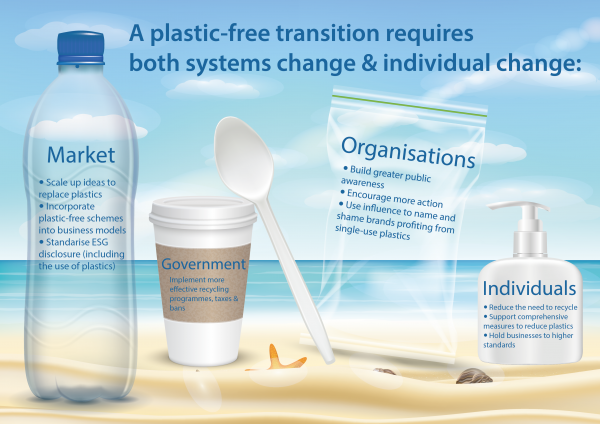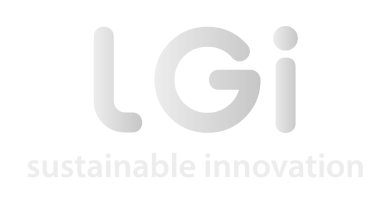12 minutes… The length of one quarter of a basketball game… the amount of time that Alexei Leonov spent on the first human spacewalk… the average time that a plastic bag gets used before being tossed. Let me repeat that. A plastic bag that is predicted to last up to 1000 years gets used on average for only 12 minutes. It’s not just plastic bags. Half of all the plastic produced worldwide is actually designed to be used just once before being thrown away. I say thrown away, because 90% never gets recycled.
Not that recycling plastic would help to extend its use time. Recycling, even for the plastics that are easiest to recycle, is often nothing more than a deviated trip to the landfill. According to 5gyres, less than one-fourth of the PET plastic that got put in recycling bins in the US (PET is the most commonly recycled plastic worldwide), actually got recycled. The reason? Basic economics. Not only do fluctuations in oil prices mean that virgin plastic is often cheaper than recycled plastic, but plastic products decrease in value each time they get processed. For more on the economics of why this is the especially the case today, read this article on single-stream recycling machines. Long story short, it often doesn’t make financial sense to buy recycled plastic, and plastics of all kinds now have a greater chance of making it to a landfill near you, quicker than ever before.
It’s on their way to the landfill that many plastics get blown away, ending up in drains or rivers, which is how they eventually get carried out to the ocean. It’s estimated that every minute the equivalent of a truckload of plastic gets “dumped” into the ocean this way. Images showing what happens next are heart-wrenching… a beached pregnant whale, dead from 50 pounds of plastic inside… a sea turtle with a plastic straw stuck in its nose… a seal pup with fishing line cutting into its neck… such sad images of marine life being affected by plastic are becoming all too common. We can only hope that we do not become desensitised to the current reality. In the Great Pacific Garbage Patch, 1.8 trillion pieces of plastic now take up an area equal to the size of France. Such accumulations not only tax Mother Nature, but they represent unnecessary costs to society. In fact, the negative impact that plastic debris has on the marine environment is estimated to be around USD 13 billion each year.
Plastics also wash into the ocean via the drains in our own homes. I remember the shock I felt when I first heard about microbeads – the very same microbeads that had made my facewash at the time my beloved “product of the year.” How could I have been so naïve to not think twice about what I was putting on my face and then washing down the drain? As a self-proclaimed environmentalist, feelings of guilt were awash. Then frustration and confusion. How could there be so little oversight of what companies were selling on the mass market? Fortunately today, societal awareness is leading to legislation that helps cut back on the plastics being used, in the form of both taxes (such as small levies on plastic bags) and bans (such as the one Obama signed on microbeads in 2015).
Legislation is greatly needed, but it is not enough. While some taxes have had great success, a detailed analysis of Toronto’s bag levy shows that it was largely ineffective, with the use of reusable shopping bags increasing only 3.4% after it was enacted (the desired behaviour change came largely from those of high socio-economic status who were already using reusable bags.) Bans are also sort of a mixed bag (pun intended). They often have unintended consequences (see this article for how plastic trash bag sales increased after a grocery bag ban was introduced in New York, and how paper and tote bags are actually thought to be worse for the environment!) Depending on the authority and the product, bans may have lax enforcement, reducing their effectiveness. Loopholes also abound. In the case of microbeads, for example, bans may only specify “rinse-off cosmetics,” meaning other products can continue to use them. This site tracks various brands and products containing microbeads. Whether it is toothpaste, make up or shampoo, microplastics still exist in several of our everyday household items, without any indication from the manufacturers of ever stopping.
So where does this leave us? Clearly the best way to reduce plastic use is to just not buy plastics in the first place. However, plastics are incredibly abundant today and it is hard for even the most stringent environmentalist to avoid them completely. A multi-pronged solution is needed, and it will take teamwork at a global level to make it happen. More effective recycling programmes, taxes, and bans are needed. WRI notes that this should include regulating plastic throughout its lifecycle (rather than just retail aspects), implementing full bans as opposed to partial bans, and providing subsidies for plastic alternatives, among others. Governments need to know that we support more comprehensive measures, as does the market. This will enable innovative ideas to be scaled up quickly… ideas such as this edible six-pack ring created by a small brewery (Saltwater Brewery), or those of start-ups such as RECONCIL and Vessel Works, where disposable food and beverage containers are replaced with reusable ones through programme memberships. Clever schemes need to be incorporated into existing business models, such as plastic-free supermarket aisles, plastic-free “trust mark” food labels guiding shoppers to more sustainable purchases, and product lines made from plastic waste found on the beach, such as the shoe line of Adidas and Parley. Such methods require less risk-taking and thus appeal to more companies, since the companies do not have to change their entire operations or business model – they just tweak certain aspects or add to their offer.
Speaking of companies, we must hold businesses to higher standards. I personally find it shocking that in 2019 there is (still) no standardised ESG disclosure among listed companies or stock exchange regulators (for more information on what is being done to advance corporate performance on ESG issues, check out the Sustainable Stock Exchanges initiative). More grassroots action is needed to encourage such system-wide behaviour change. Greenpeace’s #IsThisYours campaign uses social media to name and shame the brands of plastic products that are found on the ground. Other popular campaigns, such as the #NoStrawNovember campaign and the #BeatPlasticPollution tag campaign, help to build awareness while also encouraging change at an individual level.
This last part is crucial. We must not forget that a successful plastic-free transition will require both systems change and individual change. The above actions aim to reduce plastic use largely from the supply side. But they must also be met by actions from the demand-side (us). Years ago in school, we were to taught to recycle. Now we must teach ourselves and our children to make decisions so that there is no need to recycle in the first place.

P.S. For anyone who has already bought rinse-off microbeads, here is useful advice I found on how to best get rid of them, with as little harm to the environment as possible.

The views and opinions expressed in this blogpost are solely those of the original author(s) and/or contributor(s). These views and opinions do not necessarily represent those of LGI or the totality of its staff.




FOLLOW US